A CANCER drug that’s been used on the NHS for 30 years could also help clear blocked noses.
A clinical trial is under way to see if paclitaxel, a chemotherapy drug, can help treat chronic sinusitis, which affects one in 10 UK adults.
Sinusitis develops when the nasal passages and the lining of the sinuses — air-filled cavities behind the nose, cheeks and eyes — become inflamed and blocked, often as a result of a viral infection such as a cold or flu. This inflammation can lead to difficulty breathing through the nose, and pain or tenderness around the eyes and nose.
Most cases clear up in couple of weeks, once the underlying infection goes, but some people develop chronic sinusitis, lasting several months or even years.
Far from being a minor ailment, studies suggest chronic sinusitis can lead to pain and discomfort as bad as conditions such as arthritis. The symptoms range from a constant runny nose or stuffiness, to a reduced sense of smell.

The inflammation can also lead to the formation of polyps, tiny growths in the sinuses that block air flow and can require surgery under a general anaesthetic to have them removed.
Now a team at the National University of Asuncion in Paraguay hopes paclitaxel will help patients avoid surgery and the risks associated with a general anaesthetic.
Paclitaxel — launched in 1993 — is best known as a treatment for breast, ovarian and lung cancers.
More recently it has been used to coat stents (tiny metal tubes) to help clear blocked arteries in patients with poor blood flow in their legs from conditions such as peripheral arterial disease.
This condition occurs when fatty deposits called plaques restrict blood flow in the small arteries in the legs, causing symptoms such as pain when walking.
Stents can clear the blockage, but the implantation procedure causes scar tissue to form on the lining of the arteries. As this scar tissue contracts, it narrows the space for blood to pass through the artery, leading to another partial blockage.
Paclitaxel is added as a coating as it prevents the formation of scar tissue by preventing tissue cells rapidly multiplying. The theory is that the drug will have a similar effect in chronic sinusitis.
It does not cause the same side-effects as when used as chemotherapy to treat cancer because it is a much smaller dose and there is not repeated exposure.
The researchers running the new trial, involving 45 patients, plan to use tiny balloons no bigger than a grain of rice, which are coated with paclitaxel to open up the blocked sinuses.
The balloon will be inserted via the nose. Once it is in position on the blockage, it will be inflated so that it gently presses against the inflamed tissue.
This helps to clear the blockage physically, but in addition the drug is immediately absorbed by cells in the lining of the sinuses, reducing inflammation and, just as with cancer cells, it will stop them from rapidly multiplying and causing another blockage.
The first results from the trial are expected at the end of 2024.
Simon Gane, a surgeon at the Royal National Throat, Nose and Ear Hospital in London, said: "This is an interesting idea and could potentially be useful.
"But in chronic sinusitis, all the sinus cavities [there are four — behind the cheekbones, the forehead and either side of the nose] tend to become blocked, so you may need lots of balloon treatments in order for it to work."
© Solo dmg media








